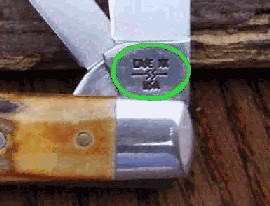Case Pocket Knife Age Identification
Throughout the long history of W. R. Case & Sons, there have been many different stamps used on its knives. These stamps are located on the tang of the master blade, and can be used to help identify when the knife was manufactured.
Below is a picture of where the stamp is located, along with the most common stamps and the years that they were used. Keep in mind that a knife's tang stamp alone cannot be relied upon for a 100% positive identification of age.
There are counterfeits out there, so knowing other details about knives of various eras is also important. Shields, bone & other handle cover colors & styles, jigging patterns, hafting techniques & more can be used for further validation.
Shopping trusted sites & trusted knife dealers is something we highly recommend to all beginner & intermediate collectors. Thankfully, we have trusted sellers in the AAPK member stores where you can buy with confidence. Shop for Case knives in our stores now!

|
Pre-1920
The above stamps were the most common used by Case on knives that were manufactured in the years prior to 1920. |
|
1920-1940 (some say 1919 - 1945)
You will find that most books date this stamp as being used from 1920 to 1940. I have found that many serious knife collectors disagree with this date range and say that it was actually used from 1919 to 1945. It has been my experience that collectors call knives with these stamps "Tested" or "Circle C" era knives. |
|
1940-1964 (some say 1945 - 1964)
You will find that most books date this stamp as 1940 - 1964. I have found that many serious knife collectors say that it was actually used from 1945 - 1964. It has been my experience that collectors call knives with these stamps "XX" era knives. |
|
1945-1950
|
1950-1964
|
1965-1969
|
|
1970-1979
The stamps used from 1970-1979 are the same as those used between 1965-1969 except that dots were added below the U.S.A. 10 dots were added in 1970, and for every year thereafter, one dot was removed so that each year had a unique stamp. For clarification, note that ten dots appear on 1970 knives, nine dots appear in 1971 knives, eight on 1972 knives, and so on. |
|
1980-1989
Throughout the 1980's, Case used the same dating system as the 70's. 1980 knives have 10 dots, and one is removed each year. Unlike 70's knives however, the s's are lightening shaped, and the dots are located between the Case XX, and the U.S.A. |
|
1990-1993
Beginning in 1990, Case replaced the dating system with a stamp that imprinted the actual date on the knife tang. This was not as popular with collectors, so Case changed back to the dot dating system in the middle of 1993.
|
|
1993 -1999
From the middle of 1993 to 1999, Case returned to the dot system that was used in the 70's and 80's. Case also returned to using a long tailed C on the word Case which resembled the older tang stamps. The dots started in 1993, and one was removed for every year until 2000. On some knives in this era, the S in U.S.A. is lightening shaped like those in the 80's. |
|
2000 - 2009
In 2000, Case developed a dating system using an old style Case XX stamp along with a mix of dots and x's both above the Case XX symbol and below. Case started with 5 x's, and 5 dots in 2000. For each year thereafter, they removed one dot. When all of the dots were gone after 2005, the x's were removed one by one until 2010. |
|
2010 - 2019
For the year 2010, Case switched to a tang stamp dating system similar to the prior decade (2000 - 2009). The 2010 stamp started with 3 xs, 2 dots on top & 2 xs 3 dots on bottom. One dot removed for each year up to and including 2015. For each year thereafter, one x removed each year. 2019 knives will have a single x. |
|
2020 - 2029
For the year 2020, Case switched back to a “ten-dot” dating system - and used a variation of the lightening S ’CASE XX’ marking. The 2020 stamp will have 10 dots. One dot will be removed for each year until 2030 will surely usher in a new look. |














